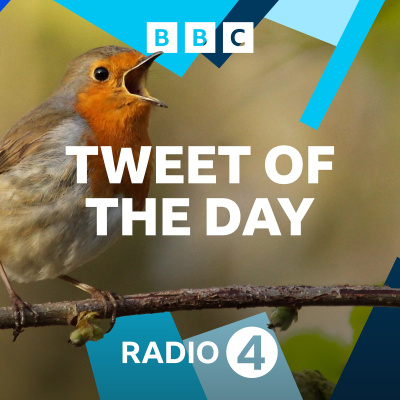Sinopsis
Discover birds through their songs and calls. Each Tweet of the Day begins with a call or song, followed by a story of fascinating ornithology inspired by the sound.
Episodios
-
Shoebill
02/10/2014 Duración: 01minTweet of the Day is the voice of birds and our relationship with them, from around the world. Miranda Krestovnikoff presents the mysterious shoebill of Uganda. Reaching almost one and a quarter metres in height and looking like a hefty-looking blue-grey stork, ornithologists remain unsure which birds are their closest relatives. As its name suggests, the Shoebill's most outstanding feature, is its enormous clog-shaped bill. Up to 20cm long, half as wide and ending in a nail-like hook. They live in central and east African swamps where they feed on reptiles, fish, amphibians and even young crocodiles. Their bill is also useful in the baking heat of the African sun, when the adults scoop up beak-fulls of water and shower it over their chicks to help them keep cool.Producer : Andrew Dawes
-
Brown Kiwi
01/10/2014 Duración: 01minTweet of the Day is the voice of birds and our relationship with them, from around the world.Miranda Krestovnikoff presents the New Zealand brown kiwi. A piercing wail can be heard in a forest at night. A brown kiwi is calling. Only found in New Zealand, kiwi are flightless birds and the brown kiwi, which is about the size of a domestic chicken, lays an egg weighing as much as a quarter of its own bodyweight – proportionally; the largest egg for its size of any bird. More mammal like than birds; their tiny eyes are of little use, but they have an excellent sense of smell, using their nostrils located unusually for birds near the end of the bill. Held in great affection, brown kiwi appear on coins, stamps and coats-of- arms as well as providing a nick-name for New Zealand's national rugby team.Producer: Andrew Dawes
-
African Jacana
30/09/2014 Duración: 01minTweet of the Day is the voice of birds and our relationship with them, from around the world. Miranda Krestovnikoff presents the wetland loving African Jacana. Being rich chestnut coloured above, with black heads, white throats, each has a patch of blue skin above the bill, known as a shield, Jacanas are waders with very long slender toes which allow them to walk on floating plants giving them the name lily-trotters. Widespread in wet places south of the Sahara desert they may become nomadic moving between wetlands as seasonal water levels change. They have an unusual mating system. Females mate with several males, but leave their partners to build the nest, incubate the eggs and bring up the chicks. With up to 3 or 4 mates rearing her different broods, her strategy is to produce the maximum number of young lily-trotters each year.Producer : Andrew Dawes
-
African Southern Ground Hornbill
29/09/2014 Duración: 01minTweet of the Day is the voice of birds and our relationship with them, from around the world.Miranda Krestovnikoff presents the African southern ground hornbill. Ground hornbills live in south and south east Africa. They're glossy black birds, as big as turkeys with huge downward-curving bills. The bird produces a deep booming sound that reverberates over long distances, sometimes as much as 5 kilometres, across its grassy habitat. Preferring to walk rather than fly, they strut about in the long grass, searching for prey. Snakes are a favourite: even deadly puff adders are no match for the birds' bludgeoning beaks.
-
Emperor Penguin
26/09/2014 Duración: 01minTweet of the Day is the voice of birds and our relationship with them, from around the world. Sir David Attenborough presents the emperor penguin from the Antarctic Peninsula. With temperatures down to minus 50oC, midwinter blizzards scouring one of the most inhospitable places on the planet, this is not an obvious location for raising young. Yet at the heart of this landscape, the world's largest penguin, the emperor, stands guard over their young. Tightly-packed colonies of hundreds or sometimes thousands of birds huddle together, to conserve heat. The male broods the single egg on his feet, protected under folds of bare abdominal skin. Females travel up to 100km from the colony in search of food, using a technique called tobogganing which is far more efficient than walking on their short legs. Harsh though the landscape is in midwinter, all this activity is co-ordinated to allow the young to fledge into the relatively warmth of an Antarctic summer.
-
Laughing Gull
25/09/2014 Duración: 01minTweet of the Day is the voice of birds and our relationship with them, from around the world.Sir David Attenborough presents the laughing gull off the Florida coast. In summer, the hearty peal of laughter is one of the characteristic sounds people hear along the North American east coast where laughing gulls come to breed. America's version of the British black-headed gull they are easy to recognise as they patrol the seashore in search for food. Like many gulls they eat what they can find and will scavenge at rubbish dumps, and will even feast on the eggs of horseshoe crabs which spawn in Deleware Bay each spring. Some become swept up in autumnal hurricanes and having crossed the Atlantic, occasionally turn up on a European's bird-watching list.
-
Eurasian Scops Owl
24/09/2014 Duración: 01minTweet of the Day is the voice of birds and our relationship with them, from around the world.Sir David Attenborough presents the Eurasian scops owl found in Mediterranean regions. In summer a mournful monosyllabic call interrupts the heady scented air of a Greek olive grove at dusk. A male scops owl is proclaiming his territory with a repeated call lasting over 20 minutes. Hearing these tiny owls, no bigger than a starling is one thing, seeing one roosting in an old tree is quite a challenge. They feed mainly on moths and beetles which they hunt for in open country with scattered trees. By autumn these largely nocturnal birds are heading south to sub-Saharan Africa, until the following spring when once again the olive groves resound to their plaintive song.
-
Vogelkop Bowerbird
23/09/2014 Duración: 01minTweet of the Day is the voice of birds and our relationship with them, from around the world.Sir David Attenborough presents the Vogelkop bowerbird of west New Guinea. The forest floor resembles a market stall with neat piles of brightly-coloured fruits and leaves placed carefully on a mossy lawn in front of a cave of thatched twigs. This is the work of the Vogelkop bowerbird. Native to New Guinea and Australia, this drab olive brown male, uses aesthetic tastes to bring vibrancy of colour into his life: and to woo his mate. His brightly coloured exhibits are graded for size and colour and any withered or faded items are quickly replaced. Satisfied with his work, he whistles, and growls to entice her to a private view. After mating the female departs to rear her single chick unaided, while the male returns to the task of tending his creation.
-
Sociable Weaver
22/09/2014 Duración: 01minTweet of the Day is the voice of birds and our relationship with them, from around the world. Sir David Attenborough presents the sociable weaver of the Kalahari Desert in Namibia. Travel through the dry margins of the Kalahari Desert and the telegraph poles stretching across the treeless plain could be wearing giant haystacks. These colossal communal homes are actually a home to the sociable weaver. These sparrow relatives build the largest nesting structure of any bird in the world. A hundred pairs may breed in a nest weighing nearly one tonne, built on isolated trees or any suitable man made structure such as pylons. Developed over generations these colonial nests provide a cooling structure during the searing heat of day and a warm refuge for night time roosts in this inhospitable landscape. Other animals find a use for these structures, from nesting vultures using it as a safe platform, to snakes; who if they enter the nest, can have free rein to this weaver larder.
-
Black Stork
21/09/2014 Duración: 01minTweet of the Day is the voice of birds and our relationship with them, from around the world. Sir David Attenborough presents the globally widespread but secretive black stork. High up in a forest canopy, the black stork is a large but fairly secretive and mostly silent bird. They are also strong migrants capable of sustained flight, flying up to 7,000 kilometres or more, often over open seas. Black storks are summer visitors to eastern Europe and breed from Germany across Russia to Japan. A small population is resident in Spain, but most birds migrate south in winter to Africa, India or China. Unlike their relative the more flamboyant and colonial nesting white stork, black storks are a solitary nester. It is at this time of the year adults can produce a few grunts or bill clapping sounds during courtship, the young however are far more vocal at the nest.
-
Superb Lyrebird
18/09/2014 Duración: 01minTweet of the Day is the voice of birds and our relationship with them, from around the world. Sir David Attenborough presents the superb lyrebird of eastern Australia. Superb lyrebirds are about the size of pheasants. During courtship, as the male struts and poses, he unleashes a remarkable range of sounds. Up to 80% of the lyrebird's display calls are usually of other wild birds. However, if kept in captivity, they can mimic a chainsaw, camera click, gunshot and a whole host of other man made sound. Research recently discovered that the lyrebird co-ordinates his dancing displays to particular sounds. But superb lyrebirds are promiscuous performers and it's quite likely that another male may have played the leading role while he dances and sings away.
-
Red-headed Woodpecker
17/09/2014 Duración: 01minTweet of the Day is the voice of birds and our relationship with them, from around the world.Sir David Attenborough presents the red-headed woodpecker found in North America. With its inky black wings, snow white body and crimson hood, the red-headed woodpecker is one of the most striking members of its family, a real 'flying checker-board'. This striking Woodpecker has an ancient past, fossil records go back 2 million years and the Cherokee Indians used this species as a war symbol. More recently and nestled amongst Longfellow's epic poem The Song of Hiawatha, the grateful Hiawatha gave the red headed woodpecker its red head in thanks for its service to him.Producer : Andrew Dawes
-
Spix's Macaw
16/09/2014 Duración: 01minTweet of the Day is the voice of birds and our relationship with them, from around the world.Sir David Attenborough presents the now extinct in the wild, Spix's macaw. The Spix's macaw was declared extinct in 2000 when the last known wild born male disappeared from its final refuge in Brazil. Fortunately this strikingly beautiful member of the parrot family survives in captivity. The Al-Wabra Wildlife Preservation centre in Qatar is providing a reservoir for an organised breeding programme which is now managed by several conservation organisations under the guidance of the Brazilian government. Soon it is hoped the bird that inspired the film Rio, can once more fly free in the wild.
-
Guira Cuckoo
15/09/2014 Duración: 01minTweet of the Day is the voice of birds and our relationship with them, from around the world. Sir David Attenborough presents the guira cuckoo of central South America. Guira cuckoos break all the usual rules of their family. They are very sociable and travel in noisy gangs, feeding and roosting together. But what makes the behaviour of guira cuckoos so different is that several females often lay their eggs in a single nest, sometimes as many as 20 eggs which are tended by the respective mothers . This is known as co-operative breeding. Whether a female recognises her own eggs isn't certain, but it's possible that they can distinguish them by variable markings on the eggshells and single them out for special care.
-
Wrybill
12/09/2014 Duración: 01minTweet of the Day is the voice of birds and our relationship with them, from around the world. Sir David Attenborough presents the New Zealand wrybill. The wrybill is an inconspicuous wader yet it is unique. It is the only bird in the world whose bill is bent sideways , and as it happens, always to the right. In the shingly, gravelly world it inhabits alongside fast flowing rivers, the wrybill's beak is the perfect shape for finding food. With neat, rapid movements, it sweeps aside small stones to reveal insects beneath. Endemic to New Zealand in winter dense flocks gather and display, their highly co-ordinated aerial movements having been described as a flung scarfe across the sky.Producer : Andrew Dawes
-
Dupont's Lark
11/09/2014 Duración: 01minTweet of the Day is the voice of birds and our relationship with them, from around the world. Sir David Attenborough presents the Dupont's lark of southern Europe and North Africa. The European home for the Duponts lark is the arid grasslands of south-east Spain where Spaghetti Westerns were once filmed. The Dupont's lark is notoriously difficult to find as it skulks between tussocks of dry but at dawn and again at sunset, male Dupont's larks emerge from their hiding places and perform display flights over their grassy territories. As they rise into the sky their song is a melancholy refrain, which once heard is rarely forgotten.
-
White-Bearded Manakin
10/09/2014 Duración: 01minTweet of the Day is the voice of birds and our relationship with them, from around the world.Sir David Attenborough presents the White-Bearded manakin of tropical South America. The sound of party-poppers exploding in a forest clearing tells you that white-bearded manakins are displaying at a lek. At a carefully chosen spot each male clears the forest floor of leaves and other debris before his performance begins. The commonest display is the snap-jump. As he jumps forward he strikes the back of his wings together creating a loud snapping sound followed by an excited "pee-you" call. Snap-jumps are often followed by grunt jumps or a manoeuvre known as "slide-down-the-pole". These displays continue throughout the day, but intensify when females visit.Producer : Andrew Dawes
-
Florida Scrub Jay
09/09/2014 Duración: 01minTweet of the Day is the voice of birds and our relationship with them, from around the world. Sir David Attenborough presents the Florida scrub jay. Less than 6,000 Florida scrub jays exist in the wild, yet these are some of the most intelligent creatures in the world. Long term research has revealed an extraordinary intelligence. If other jays are around, a bird will only hide its food when the other bird is out of sight. It will even choose a quieter medium, and rather than pebbles for example, to further avoid revealing its hidden larder to sharp-eared competitors.
-
Red-winged Blackbird
08/09/2014 Duración: 01minTweet of the Day is the voice of birds and our relationship with them, from around the world. Sir David Attenborough presents the North American red-winged blackbird. The arrival of spring in the USA is heralded by the unmistakable "conk-ra-lee" call of the red-winged blackbird. The male blackbirds, who are un-related to the European blackbird, flutter their red and yellow wing-patches like regimental badges to announce their territories. The numbers of Red-winged blackbirds has increased spectacularly in the mid 20th century as more land was converted to growing crops on which the birds feed. Today at a winter roost hundreds of thousands, even millions of birds darken the skies over the plantations or marshes in which they will spend the night - a loud and unforgettable spectacle.
-
Brown Noddy
05/09/2014 Duración: 01minTweet of the Day is the voice of birds and our relationship with them, from around the world. Sir David Attenborough presents a seabird with a worldwide distribution, the brown noddy. Expert fliers, the brown noddy is seldom seen near land and is highly pelagic, wandering extensively in warm tropical waters where it searches for small fish and squid which are captured by hover-dipping and contact-dipping. However in the Galapagos Islands, brown noddies have learnt to sit on the heads of brown pelicans hoping to steal fish from their open gular pouches; a behaviour known as kleptoparasitism (literally, parasitism by theft).














